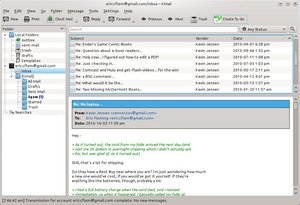There are a few very popular email clients for Linux users. The big two are Evolution and Thunderbird. Evolution is a total solution, which includes not only email, but contacts, calendars, and more. It is installed by default in Ubuntu and other popular distributions. Thunderbird is a bit leaner, focusing mainly on email (although there are extensions to allow for calendar features). It is developed by the same group – Mozilla – responsible for the Firefox web browser. But those aren’t the only two options Linux users have. The option I’ll be writing about is called KMail, an email client for KDE.
KMail comes installed by default on many, if not most, KDE-based distributions. You may not see it in your menu system (sometimes it isn’t given its own launcher), but if you see something called Kontact (the KDE personal information manager), then you have KMail installed. KMail and KOrganizer are at the heart of Kontact. Kmail for email and KOrganizer for calenders, to-do lists and journaling. Both can be installed on their own, but both also work well together.
For most people familiar with email clients, KMail’s interface should feel very comfortable. Setting up accounts is pretty standard. Enter in the email server (Kmail supports both POP and IMAP, as well as local mailbox and maildir mailbox), your credentials, and tweak any port settings you need. POP mail will be downloaded as you check for it, or can be left on the server, while the IMAP protocol allows you to access your email from anywhere, while keeping your desktop and Web clients synchronized at all times.
In case you’re wondering, KMail is simple to set up with Gmail, using either POP or IMAP. Just follow the directions linked to from the Gmail POP and IMAP settings tab, and everything should work great.
One of KMail’s strong points is in its flexibility. KDE has a reputation for being highly configurable (sometimes almost to a fault, according to some users), and KMail is no exception. Don’t like the layout provided? You can tweak it from one of a few different settings. Colors or labels don’t feel right? You can change them as well. You can choose how much header information is shown, how KMail treats images and other resources from the Internet (show them or not?), and how to treat HTML emails, which can sometimes cause security concerns.
KMail does support HTML emails, both sending and receiving, although there’s no preference setting that allows you to choose HTML email as your default way to send email. It’s in the menu system when you click to send a new mail. The first email will be plain text until you change it to HTML, which will then be the setting until you change it back. Kind of weird. Regardless, however, if you’re looking for an email client to put together all kinds of template-driven emails (as Apple touts its email client), then you’d probably be better off looking elsewhere.
What else? KMail includes pretty much a standard menu of common email features. Signatures, encryption, message filters, spam filters, message thread view, spell check, public key support, attachments… all are supported, and in a manner that again should be instantly familiar to computer users. You can keep your addresses in the address book and even create to-do lists. Those last two features, however, don’t actually belong to KMail, but to two other programs, the aforementioned KOrganizer (for the to-do lists), and KAddressBook (for the address book). This is another instance of how tightly integrated many KDE programs are. They share the same database, so can share information between themselves very simply, making each program better than it would be otherwise, and the whole larger than the sum of its parts.
KMail isn’t the greatest email program ever. That’s not to say it isn’t good, because it is! There are just a few things about it (its handling of HTML mail being one), that would have me – in a completely “level” playing field between KDE and GNOME applications, choosing something like Thunderbird. But KMail is very solid, has worked with any account I’ve thrown at it and for KDE users is an excellent choice. It’s tightly integrated with KDE and Kontact (something Thunderbird can’t say), and behaves as you’d expect. And for as basic as it might appear, it has more features than you might at first guess. It’s simple yet powerful, and I guess the best compliment I can give it is that once I tried out the newest version (upon installing Kubuntu 10.10 a few days ago), I didn’t feel the need to go looking for anything else.
http://kontact.kde.org/kmail/
